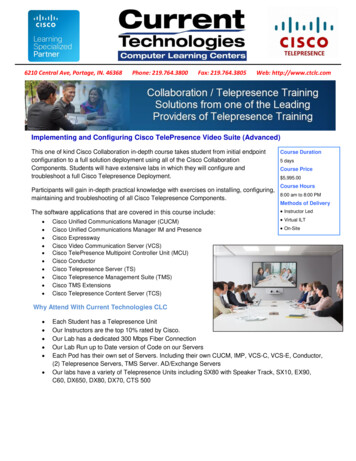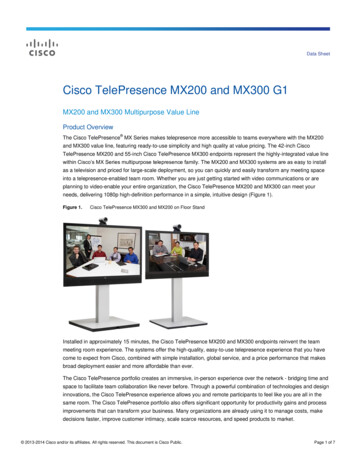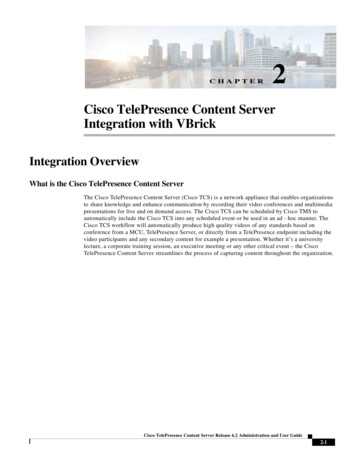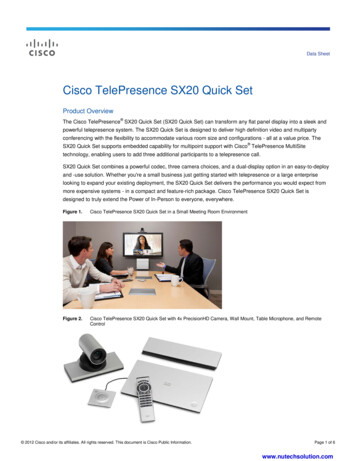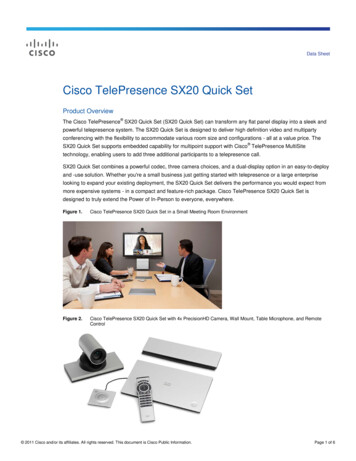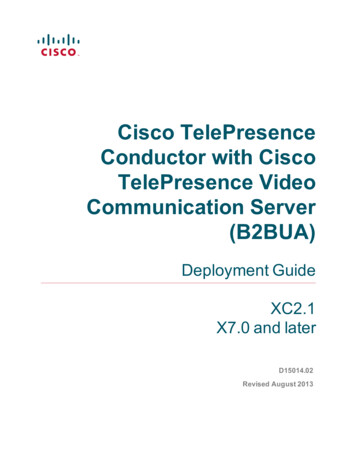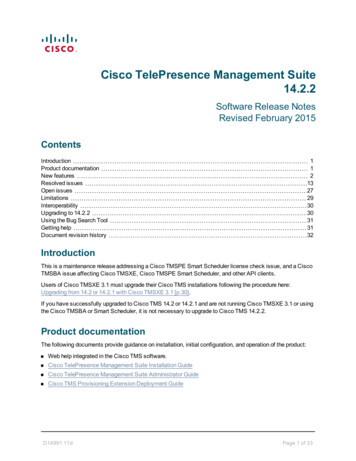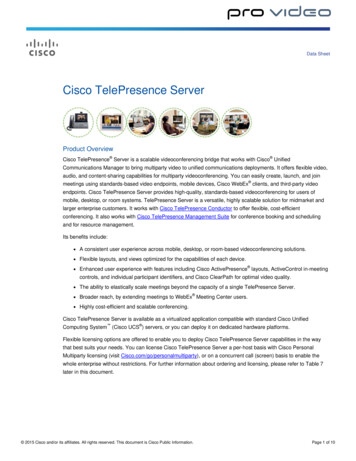
Transcription
Data SheetCisco TelePresence ServerProduct OverviewCisco TelePresence Server is a scalable videoconferencing bridge that works with Cisco UnifiedCommunications Manager to bring multiparty video to unified communications deployments. It offers flexible video,audio, and content-sharing capabilities for multiparty videoconferencing. You can easily create, launch, and joinmeetings using standards-based video endpoints, mobile devices, Cisco WebEx clients, and third-party videoendpoints. Cisco TelePresence Server provides high-quality, standards-based videoconferencing for users ofmobile, desktop, or room systems. TelePresence Server is a versatile, highly scalable solution for midmarket andlarger enterprise customers. It works with Cisco TelePresence Conductor to offer flexible, cost-efficientconferencing. It also works with Cisco TelePresence Management Suite for conference booking and schedulingand for resource management.Its benefits include: A consistent user experience across mobile, desktop, or room-based videoconferencing solutions. Flexible layouts, and views optimized for the capabilities of each device. Enhanced user experience with features including Cisco ActivePresence layouts, ActiveControl in-meetingcontrols, and individual participant identifiers, and Cisco ClearPath for optimal video quality. The ability to elastically scale meetings beyond the capacity of a single TelePresence Server. Broader reach, by extending meetings to WebEx Meeting Center users. Highly cost-efficient and scalable conferencing.Cisco TelePresence Server is available as a virtualized application compatible with standard Cisco UnifiedComputing System (Cisco UCS ) servers, or you can deploy it on dedicated hardware platforms.Flexible licensing options are offered to enable you to deploy Cisco TelePresence Server capabilities in the waythat best suits your needs. You can license Cisco TelePresence Server a per-host basis with Cisco PersonalMultiparty licensing (visit Cisco.com/go/personalmultiparty), or on a concurrent call (screen) basis to enable thewhole enterprise without restrictions. For further information about ordering and licensing, please refer to Table 7later in this document. 2015 Cisco and/or its affiliates. All rights reserved. This document is Cisco Public Information.Page 1 of 10
Figure 1 shows examples of supported modes of Cisco TelePresence Server.Figure 1.Examples of Cisco TelePresence Server Supported ModesA critical requirement for all customers is ensuring a high return on investment (ROI). TelePresence Server has asoftware upgrade path that enables you to deploy new features as required, and with a cost-effective licensingmodel you can closely manage your investment while reaping the rewards of enhanced business agility, fasterdecision making, lower travel expenses and increased employee productivity.Designed to meet the needs of organizations from small businesses to global multinationals, TelePresence Serverhas a scalable architecture, enabling you to start small and increase the scale of your solutions as your businessgrows.Cisco TelePresence Server is compatible with a range of hardware platforms, enabling you to select the solutionmost suited to your needs: The Cisco TelePresence Server on Virtual Machine, has been optimized to run on the Multiparty Media400v but also runs on Business edition 6000 and 7000 as well as Cisco UCS or third-party specificationbased server platforms. The Cisco TelePresence Server on Multiparty Media 310 and Multiparty Media 320 entry-level appliancesolutions can be stacked to grow with your business video usage over the long term. The Cisco TelePresence Server on Cisco TelePresence Server MSE 8710 (Cisco TelePresence Server onCisco MSE 8710) is a chassis-based platform that is ideal for large enterprises and service providersrequiring a high-availability and highly scalable solution. Scalability is achieved through clustering up to fourCisco MSE 8710 blades as a single unit. The Cisco TelePresence Server can also run on the Cisco MSE 8510 and Cisco TelePresence MCU 5300(MCU 5300) platforms.Benefits of Cisco TelePresence Server A consistent, intuitive meeting experience for users with standards based mobile, desktop, and immersivevideo systems. The ability to extend meetings beyond the capacity of one server by cascading server to server or to includeWebEx Meeting Center users, extending the scale of meetings and enabling more people to join meetings. Improved productivity: All users enjoy a high-quality experience, accessible from mobile devices running theJabber application through to desktop or immersive systems. Thus remote and home workers cancollaborate more effectively and decrease travel costs. 2015 Cisco and/or its affiliates. All rights reserved. This document is Cisco Public Information.Page 2 of 10
FeaturesTable 1 lists the features of Cisco TelePresence Server.Table 1.Cisco TelePresence Server FeaturesFeatureDescriptionDesign features The server is standards-based and compatible with major vendors’ videoconferencing endpoints. It is highly scalable to meet current and future organizational needs. It provides participants with the best possible view for their endpoint. The server provides an easy-to-use and versatile management interface. It is designed to carrier-class levels of reliability and availability. The server is compatible with a range of dedicated hardware platforms or Cisco UCS servers.Application features Cisco TelePresence ActivePresence capability supports a full-screen immersive view of the primary speakerswith an overlay of others in the call; it is designed to maximize the large-scale immersive experience and isavailable on all ports. Cisco TelePresence ActiveControl allows you to see the participant lists and control conferences and layouts. It supports single and multiscreen standards-based telepresence systems. The server interworks with Polycom RPX and TPX telepresence systems while preserving the full CiscoActivePresence view. It integrates with Cisco TelePresence Management Suite (Cisco TMS) and Cisco TelePresence Conductor. The Cisco TelePresence Server on Cisco MSE 8710 or Cisco TelePresence Server 7010 can be locallymanaged or remotely managed (by Cisco TelePresence Conductor). All other versions can be run only inremotely managed mode. Four layout families are provided for single-screen endpoints including panel-switched Cisco ActivePresencecapability. Participants can dial in or can be called from the web interface.Performance features Automatic Gain Control (AGC) is supported to adjust audio controls to help ensure a consistent experience. Cisco ClearPath is supported, providing improved media resilience with lossy networks. Up to FullHD transcoding for both video and content is supported for every participant. Cisco TelePresence Universal Port technology is supported. Video resolutions of 360p to FullHD are supported (up to 1080p30 or 720p60 frames per second [fps] at up to6 Mbps per screen including content with H.264). Comprehensive high-definition (HD) audio is supported. Advanced Encryption Standard (AES) encryption is supported. Integrated Cisco TelePresence ClearVision technology provides resolution enhancement. OneTable and Room-Switched configurations are supported.Product SpecificationsTables 2 through 4 list the technical; video, network, and audio; and network, management, and securityspecifications, respectively, of Cisco TelePresence Server.Table 2.Technical SpecificationsFeatureDescriptionProduct compatibility The server is standards-based and compatible with major vendors’ endpoints.Universal transcoding andtransrating The server can combine immersive, HD, standard-definition (SD), and 360p endpoints within the same virtualmeeting. The server provides automatic audio and video transcoding along with transrating on all calls. Each endpoint has its own decode and encode.Content features Automatic content handover is supported. The Cisco TelePresence Server supports standard (4:3) and widescreen (16:9) content. Dual video is supported with H.239, Binary Floor Control Protocol (BFCP), or Auto Collaborate. Picture in Picture: Video and content are composed into the video stream. Participants can have their own content transcoded at up to 1080p30 or WUXGA (1920 x 1200) @ 27 fps.Language support English is the standard language. 2015 Cisco and/or its affiliates. All rights reserved. This document is Cisco Public Information.Page 3 of 10
Table 3.Video, Network, and Audio SpecificationsBandwidth Up to 6 Mbps with both H.263 and H.264, for each screen in all conference modesVideo standards H.261 H.263 H.263 H.263 H.264Video resolution From QCIF up to 1080p (1920 x 1080) including interlaced iCIF and iSIF Aspect ratios: 4:3 and 16:9Frame rates Up to 60 fpsAudio standards G.711 G.722 G.722.1 G.723.1* (Supported only on Cisco MSE 8710 and Cisco TelePresence Server 7010 platforms) G.728 G.729 MPEG-4 AAC-LC MPEG-4 AAC-LD Polycom Siren14/G.722.1 Annex C Wideband audio mixing Ability to adjust endpoint audio gain through web interfaceAudio featuresTable 4.Network, Management, and Security Specifications H.323* BFCPProtocols Network Time Protocol (NTP) Session Initiation Protocol (SIP) Telepresence Interoperability Protocol Version 8 (TIPv8) H.235 (AES)* H.239 (dual video)* FTP* Real-Time Transfer Protocol (RTP) HTTP Secure HTTP (HTTPS) Dynamic Host Configuration Protocol (DHCP) (supported only on Cisco MSE 8710, Multiparty Media 310 and320 models, and Cisco TelePresence Server 7010 platforms)*Security featuresSupported only on Cisco MSE 8710 and Cisco TelePresence Server 7010 platforms. Personal Identification Number (PIN)-protected conferences Conference locking Secure non-PC hardware and operating system Transport Layer Security (TLS) Secure Real-Time Transport Protocol (SRTP) AES encryption, 128-bit key, and H.235 (H.235 only on Cisco MSE 8710 and Cisco TelePresence Server7010 platforms)System management An XML management application programming interface (API) is available. Cisco TelePresence Server 7010 and 8710 models can be managed through an embedded web server orremotely using Cisco TelePresence Conductor. All other platforms can be managed only remotely, usingCisco TelePresence Conductor.1 The server offers full H.323* (supported directly on Cisco MSE 8710 and Cisco TelePresence Server 7010platforms; other Cisco TelePresence Server platforms require Cisco TelePresence Video CommunicationServer [Cisco VCS] to interwork H.323) and SIP decoding, which is supported on all platforms. The server offers configurable event logs. The server offers configuration backup to network. The server offers the ability to perform secure upgrades through Ethernet.Quality of service (QoS) The server provides configurable differentiated-services-code-point (DSCP) or type-of-service (ToS)/IPPrecedence. 2015 Cisco and/or its affiliates. All rights reserved. This document is Cisco Public Information.Page 4 of 10
Network resilience1 Cisco TelePresence PacketSafe technology provides intelligent downspeeding, packet pacing, and packetloss concealment to help ensure optimum video and audio quality. The server supports dynamic jitter buffering.Cisco TelePresence Server on the Media 310 or Media 320, and Cisco TelePresence Server on Virtual Machine support onlyremotely managed mode, which requires an additional external application such as the Cisco TelePresence ConductorTable 5 gives physical specifications of Cisco TelePresence Server platforms.Table 5.Physical Specifications of Cisco TelePresence Server PlatformsCisco TelePresence MSE 8710Physical dimensions (H x W x D): 33.25 x 17.2 x 20.5 in. (842 x 437 x 520 mm) (19 rack units [19RUs]) 19-inch rack-mountable (kit supplied)Weight 14.6 lb (6.6 kg)Power Power: -8 VDC 100-40 VAC, 50-60 HzEnvironmental data Ambient operating temperature: 32 to 95 F (0 to 35 C) Relative humidity: Below 95% (noncondensing)Approvals and compliance European safety: EN 60950-1 USA/Canada Safety: UL 60950-1 CB Scheme Safety, IEC 60950-1 EMC: EN55022 Class A, EN61000-3-2, EN61000-3-3, EN55024, EN61000-4-2,-3,-4,-5,-6,-11, FCC Part15 Class A, VCCI Class A, AS/NZS CISPR 22, CCC: GB4943, GB9254, YD/T993EN61000-3-3,EN55024: EN61000-4-2,-3,-4,-5,-6,-11 RoHS compliant, WEEE: http://cisco-returns.comCisco Multiparty Media 310 and Cisco Multiparty Media 320Physical dimensions (H x W x D): 1.75 x 17.4 x 16.7 in. (44.5 x 442 x 423 mm) (1RU) 19-in. rack-mountable (kit supplied) or standaloneWeight 17.6 lb (8 kg)Power 100-40 VAC, 50-60 Hz 1177 BTU/hr (345W) maximum heat dissipationEnvironmental data Ambient operating temperature: 32 to 95 F (0 to 35 C) ambient Relative humidity below 95% (noncondensing)Approvals and compliance European Safety: EN 60950-1 USA/Canada Safety: UL 60950-1 CB Scheme Safety: IEC 60950-1 EMC: EN55022 Class A, EN61000-3-2, EN61000-3-3, EN55024, EN61000-4-2,-3,-4,-5,-6,-11, FCC Part15 Class A, VCCI Class A, AS/NZS CISPR 22, CCC: GB4943, GB9254, YD/T993 RoHS compliant, WEEE: http://cisco-returns.com Regulatory Approval Certification completed under Compliance Model Number: AD1ACisco Multiparty Media 400vPhysical dimensions (H x W x D) 1RU: 1.7 x 16.9 x 28.5 n. (4.32 x 43 x 72.4 cm)Temperature Operating 32 to 104 F (0 to 40 C) (operating, sea level, no fan fail, no CPU throttling, turbo mode)Temperature nonoperating -40 to 158 F (-40 to 70 C)Humidity operating 10 to 90% noncondensingHumidity nonoperating 5 to 93% noncondensingSafety UL 60950-1 No. 21CFR1040 Second Edition CAN/CSA-C22.2 No. 60950-1 Second Edition IEC 60950-1 Second Edition EN 60950-1 Second Edition IEC 60950-1 Second Edition AS/NZS 60950-1 GB4943 2001 2015 Cisco and/or its affiliates. All rights reserved. This document is Cisco Public Information.Page 5 of 10
Cisco Multiparty Media 400vEMC Emissions 47CFR Part 15 (CFR 47) Class A AS/NZS CISPR22 Class A CISPR2 2 Class A EN55022 Class A ICES003 Class A VCCI Class A EN61000-3-2 EN61000-3-3 KN22 Class A CNS13438 Class AEMC Immunity EN55024 CISPR24 EN300386 KN24Cisco TelePresence Server 7010Chassis physicaldimensions (H x W x D) (H x W x D): 3.43 x 17.25 x 19.1 in. (87 x 436 x 511 mm) (2RU) 19-in. rack-mountable (kit supplied) or standaloneWeight 33 lb (15kg)Power 100-40 VAC, 50/60 Hz; maximum power consumption 650WEnvironmental data Ambient operating temperature: 32 to 95 F (0 to 35 C) Relative humidity: Below 95% (noncondensing)Approvals and compliance European safety: EN 60950-1 USA/Canada safety: UL 60950-1 CB Scheme Safety, IEC 60950-1 EMC: EN55022 class A, EN61000-3-2, EN61000-3-3, EN55024, EN61000-4-2,-3,-4,-5,-6,-11, FCC Part15 Class A, VCCI Class A, AS/NZS CISPR 22, CCC: GB4943, GB9254, YD/T993 RoHS compliant, WEEE: http://cisco-returns.com Regulatory Approval Certification completed under Compliance Model Number: TR1AFigure 2 shows a graphic of the Cisco TelePresence Server interoperability solution.Figure 2.Cisco TelePresence Server Interoperability 2015 Cisco and/or its affiliates. All rights reserved. This document is Cisco Public Information.Page 6 of 10
Table 6 gives the scale parameters of Cisco TelePresence Server.Table 6.Cisco TelePresence Server Platform ScalePlatformScale ParametersCisco TelePresence ServerMSE 8710 The Cisco TelePresence Server on the Cisco MSE 8710 supports up to 48 FullHD (1080p30) or 96 HD(720p30) screens per conference when four blades are clustered. In locally managed mode the maximum capacity is achieved with 12 screen licenses per blade, giving 12 xFullHD (1080p30) or 24 x high-definition (HD) (720p30) screens. In remotely managed mode the maximum capacity per blade is still achieved with 12 screen licenses giving12 x FullHD or 24 x HD or 48 x standard-definition (SD) (w448p/480p30) or 97 x 360p resources, although theresources can be used more flexibly; please refer to Tables 8&9 for further details. Up to 200 calls are supported in one cluster of blades with up to 104 in each conference. Up to 500participants in each conference are supported in cascaded scenarios.Cisco Multiparty Media 310 The Cisco TelePresence Server on the Media 310 supports up to 5 x FullHD (1080p30) or 10 x HD (720p30),or 20 x SD, or 41 x 360p screens per unit, although the resources can be used more flexibly; please refer toTables 8&9 for further details. Maximum capacity is achieved with five screen licenses per unit. Up to two units of the Media 310 and 320 models can be stacked together to increase capacity (optionalstacking cable is required). Up to 200 calls are supported in a stack of 2 appliances with up to 104 in each conference. Up to 500participants in each conference are supported in cascaded scenarios.Cisco Multiparty Media 320 The Cisco TelePresence Server on the Media 320 supports up to 10 x Full HD (1080p30) or 20 x HD(720p30), or 40 x SD, or 81 x 360p screens per unit, although the resources can be used more flexibly; pleaserefer to Tables 8&9 for further details. Maximum capacity is achieved with 10 screen licenses per unit. Up to two units of the Media 310 and 320 models can be stacked together to increase capacity (optionalstacking cable is required). Maximum capacity of two Media 320 platforms is 20 x FullHD screen licenses. Up to 200 calls are supported in a stack of 2 appliances with up to 104 in each conference. Up to 500participants in each conference are supported in cascaded scenarios.Cisco TelePresence Server7010 The Cisco TelePresence Server 7010 supports up to 12 x FullHD (1080p30), 24 x HD (720p30), 48 x SD, or97 x 360p screens per appliance. In locally managed mode the maximum capacity is achieved with 12 screen licenses per appliance, giving 12 xFullHD (1080p30) or 24 x HD (720p30) screens. In remotely managed mode the maximum capacity per appliance is still achieved with 12 screen licensesgiving 12 x FullHD or 24 x HD or 48 x SD (w448p/480p30) or 97 x 360p resources, although the resources canbe used more flexibly; please refer to Tables 8&9 for further details. Up to 200 calls are supported on each instance of 7010 with up to 104 in each conference. Up to 500participants in each conference are supported in cascaded scenarios.Cisco UCS platform The Cisco TelePresence Server on Virtual Machine can run on a Cisco UCS C-Series Server or on otherspecifications-based hardware. The cisco Multiparty Media 400v is a dedicated UCS server which supports up to 18 x FullHD, 36 x HD, 72 xSD or 145 x 360p screens, although the resources can be used more flexibly; please refer to Table 9 forfurther details. Maximum capacity is achieved with 14 screen licenses per virtual machine. A 16-core virtual machine supports up to 10 x FullHD, 20 x HD, 40 x SD, or 81 x 360p screens, although theresources can be used more flexibly; please refer to Table 8 for further details. Maximum capacity is achievedwith 8 screen licenses per virtual machine. An 8-core virtual machine supports up to 5 x FullHD, 10 x HD, 20 x SD, or 41 x 360p screens, although theresources can be used more flexibly; please refer to Table 9 for further details. Maximum capacity is achievedwith 4 screen licenses per virtual machine. Up to 200 calls are supported on each instance of Cisco TelePresence Server on Virtual Machine with up to104 in each conference. Up to 500 participants in each conference are supported in cascaded scenarios.Note:Capacity figures represent capabilities of Cisco TelePresence Server 4.1 when used with CiscoTelePresence Conductor 3.0. 2015 Cisco and/or its affiliates. All rights reserved. This document is Cisco Public Information.Page 7 of 10
Ordering InformationTo order Cisco TelePresence Server, you will need to choose a platform then select one of the three methods oflicensing the platform as shown in Table 7. Please visit the Cisco Ordering Home Page for additional information.Table 7.Ordering InformationPlatformLicensingNamePart NumberScreen LicensesCUWL PRO and PMPBasic/AdvancedPMP Basic and Advanced a-la-carteCisco Multiparty VTS-LSVR-M3Media 400vR-VTS-K9CUWL-PRO-K9 and selectLIC-PM-V-USR-UWL (Basic)LIC-PMP-ADV-V-UWL (Advanced)TP-PMP-K9 and selectLIC-PMP-VTS-USRA (Basic) orLIC-PMP-ADV-VTS (Advanced)LIC-PMP-BTOA-VTS (upgrade fromBasic to Advanced)CiscoTelePresenceServer runningon MSE 8710CTI-8000-MSECHK9 (New chassisand blade)CTI-8710-TS-K9 (Extra blade)L-8000-CHLIC-PAKCUWL-PRO-K9 and selectLIC-PM-8X-USR-UWL (Basic)LIC-PMP-ADV-8x-UWL (Advanced)TP-PMP-K9 and selectLIC-PMP-8000-USRA (Basic)LIC-PMP-ADV-8000 (Advanced)LIC-PMP-BTOA-8000 (upgrade fromBasic to Advanced)MSE 8710 8blade andchassis bundleCTI-8710-8BFLICK9NA, bundle includesscreen licensesNANAMSE 8710 4blade andchassis bundleCTI-8710-4BFLICK9NA, bundle includesscreen licensesNANAMSE 8710 4blade upgradebundleCTI-8710-4BUPFLK9NA, bundle includesscreen licensesNANACiscoTelePresenceServer runningon CiscoMultipartyMedia 310CTI-310-TS-K9L-TS300-UPG-PAKCUWL-PRO-K9 and selectLIC-PM-3X-USR-UWL (Basic)LIC-PMP-ADV-3X-UWL (Advanced)TP-PMP-K9 and selectLIC-PMP-300-USRA (Basic) orLIC-PMP-ADV-300 (Advanced)LIC-PMP-BTOA-300 (upgrade fromBasic to Advanced)CiscoTelePresenceServer runningon CiscoMultipartyMedia 320CTI-320-TS-K9L-TS300-UPG-PAKCUWL-PRO-K9 and selectLIC-PM-3X-USR-UWL (Basic)LIC-PMP-ADV-3X-UWL (Advanced)TP-PMP-K9 and selectLIC-PMP-300-USRA (Basic) orLIC-PMP-ADV-300 (Advanced)LIC-PMP-BTOA-300 (upgrade fromBasic to Advanced)CiscoTelePresenceServer runningon TS 7010CTI-7010TPSMK2-K9L-TS7000-UPG-PAKNANATable 8.TelePresence Server Screen Licenses per Call for Each Call TypeCall Type DescriptionScreen Licenses Required perCallMain VideoAudioContent-Mono-1/52360p30†MonoIn main video⅛360p30Stereo720p5¼480p30StereoIn main p1511080p30Stereo720p301.½† 2015 Cisco and/or its affiliates. All rights reserved. This document is Cisco Public Information.Page 8 of 10
Call Type DescriptionAudioContentThree-screen 720p30Multichannel720p51.½Three-screen -screen 1080p30Stereo720p302Three-screen 1080pMultichannel720p303Three-screen 1080pMultichannel1080p304Four-screen 1080pStereo1080p304Table 9.ScreenLicensesRequiredper Call*†‡Screen Licenses Required perCallMain VideoTelePresence Server Conferencing Capacity on Various PlatformsMaximum Calls By Hardware Type (with Licenses to Provide 100% of Capacity)8 CoresVM MD8 CoresVM HDMedia 310or MCU531030 vCPU/HighDensity VM‡Media 320or MCU53207010, MSE8710 orMCU MSE8510Media 400v‡(30 vCPU)‡‡BiggestApplianceCluster (TwoAppliances)BiggestBladeCluster(FourBlades)4 ScreenLicenses5 ScreenLicenses6 ScreenLicenses10 ScreenLicenses12 ScreenLicenses12 ScreenLicenses18 ScreenLicenses24 ScreenLicenses48 612200 is the maximum number of calls possible on a Cisco TelePresence Server. It requires Cisco TelePresence ConductorXC2.3.Requires Cisco TelePresence Conductor XC2.2 or later.To achieve the maximum number of calls, Cisco TelePresence Server on Virtual Machine must be the only VM hosted on theMultiparty Media 400v or 30 vCPU/High Density VM. It cannot be co-resident with any other UC application (unlike the 8-coreoption that runs at 2.4GHz minimum and can be co-resident).‡‡Media 400v is configured with 30vCPUs as per the High Density configuration but is has a higher capacity.Note:Table 9 assumes that calls of one type are used to reach these maximum values. To calculate the totalnumber of licenses required for a variety of concurrent calls, add the screen licenses required for each concurrentcall. 2015 Cisco and/or its affiliates. All rights reserved. This document is Cisco Public Information.Page 9 of 10
Service and SupportCisco offers a wide range of services programs to accelerate customer success. These innovative servicesprograms are delivered through a unique combination of people, processes, tools, and partners, resulting in highlevels of customer satisfaction. Cisco Services help you to protect your network investment, optimize networkoperations, and prepare your network for new applications to extend network intelligence and the power of yourbusiness. For more information about Cisco Services, visit Cisco Technical Support Services orCisco TelePresence Services online.For More InformationFor more information about the Cisco TelePresence Server, please visit the Cisco TelePresence Server productpage or contact your local Cisco account representative or authorized Cisco partner. Product specifications areestimates and subject to change without notice.Printed in USA 2015 Cisco and/or its affiliates. All rights reserved. This document is Cisco Public Information.C78-728757-0601/15Page 10 of 10
TelePresence Server is a versatile, highly scalable solution for midmarket and larger enterprise customers. It works with . Cisco TelePresence Conductor to offer flexible, cost-efficient conferencing. It also works with Cisco TelePresence Management Suite for conference booking and scheduling . Jabber application through to desktop or .
